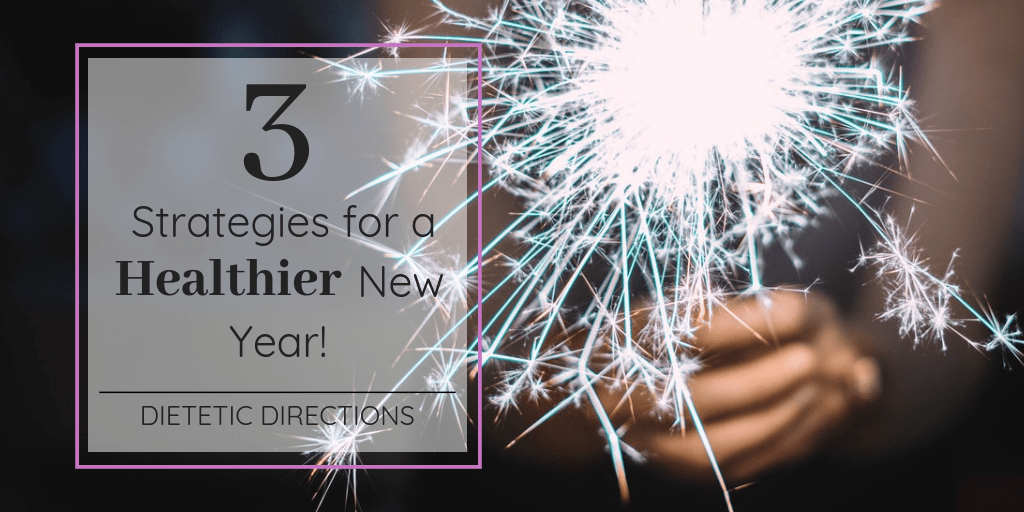
3 Strategies for a Healthier New Year!
It’s a New Year and many want to be healthier than last. What does that take? Often we set a resolution to begin new habits – going to the gym, meditating or drinking more water. However, adherence can be a challenge when we attempt many things at once. Today, I will highlight my Top 3 Strategies for a Healthier New Year! These science-based, impactful habits improve health and are rewarding enough to sustain throughout 2019.

This post was sponsored by the California Prune Board; as always, all opinions are genuine.
Before getting started, let’s do a mindset shift from the “all or nothing” mentality where you either overhaul your lifestyle (unsustainable for long-term) or give up because your perfectionist goal is unattainable. Instead, try a more moderate (and realistic) approach, like adopting one new habit and gradually another as the first one becomes routine. Similar to taking the stairs, you use the previous step to go higher.
For each of my 3 New Year’s Health Strategies, I will highlight 3 goals: the “habit”, a “plus” or way you can take this up a notch and “habit forming,” which you may need to do to facilitate regularity in your routine.

Top 3 Strategies for a Healthier New Year
1. Enjoy a ‘High-Fibre’ Breakfast.
Habit: Eat breakfast daily.
Plus: Within 2 hours of waking and when undistracted (not while driving, checking e-mails, etc.)
Habit Forming: Availability of breakfast foods and time to eat/enjoy
To start the New Year off, get into the routine of having breakfast daily. This is relevant because 40% of people miss breakfast on a regular occasion. Research shows breakfast eaters have better appetite control, which means they’re less prone to overeating later in the day. Eating fewer, larger meals predisposes the accumulation of abdominal body fat. Nutritionally, breakfast eaters are more likely to consume key nutrients like calcium, fibre and potassium. They also have enhanced memory, thinking skills, alertness and attention span.

DYK: 40% miss breakfast regularly. Here’s why eating #breakfast needs to be your #NewYearsResolution! #dietitian #health
Why ‘High-Fibre?’
Choosing a fibre-rich breakfast (i.e., whole grains like oats, quinoa, bran, fruits (fresh or dried), chia seeds, flax seeds, whole grain breads, etc.) offers numerous health benefits:
- Improved digestion: can relieve constipation and soluble fibre (found in foods like oats, chia); can help with loose bowels.
- Maintain or achieve healthy weight (fibre keeps us feeling full and it’s low in calories).
- Lowers risk of diabetes, heart disease and certain cancers.
- Lowers cholesterol and blood pressure.
- Stabilizes blood sugars.
“Eating a high-fibre breakfast lowers risk of diabetes, heart disease and can improve cholesterol and blood pressure”
High-Fibre Breakfast Inspiration
One of my favourite high-fibre breakfasts is Cherry & Prunes Oatmeal with Chia & Sunflower seeds. I love using California prunes because they add a rich flavour and texture without added sugar.
New research published in Osteoporosis International shows that they also promote bone health! In fact, in this study, eating one daily serving (about 5-6 prunes) helped postmenopausal women prevent bone loss. This lowers the risk of osteoporosis.
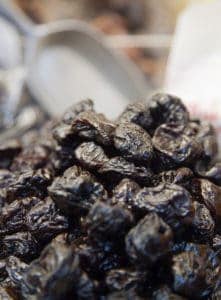
To make this oatmeal, I use ¼ cup of dry oats with ½ cup of water. I add about ½ cup of frozen cherries and dash of cinnamon. I use quick oats for busy mornings since they microwave in 1.5 to 2 minutes. Feel free to use regular or steel cut oats if you prefer. You can read about the nutrition of oats compared here.

After oatmeal is cooked, top with 3-5 chopped California prunes (only ~100 calories), 1 tablespoon of chia seeds (4 grams of fibre) and flax seeds. Sprinkle 1 tablespoon of sunflower seeds for crunch and healthy unsaturated fats. Top with 1% milk for added protein (8 grams protein) and calcium (300 mg of calcium).
Fibre Count for Breakfast: ~10 grams of fibre of the 24 grams daily recommended for women and of the 38 grams daily recommended for men. That’s impressive!
Click here for top tips for rushed mornings and here for more breakfast inspiration.
DYK: One serving of California #Prunes may slow or prevent bone loss. #prunes4bones #EatCAPrunes #ad
Tips to Get Started:
- Adapt your schedule to make breakfast happen. Some clients choose to go to bed earlier so they can wake up earlier.
- Try slowing down in the morning to make time for eating! How we start our day is often how the day progresses.
- Utilize grab-and-go alternatives, which is a better option than missing breakfast. Here are some ideas for balanced grab-and-go breakfasts.
- Choose a high fibre cereal with five grams of fibre or more per serving. I love adding bran buds to cereal for a super high fibre boost.
- Have small, glass/plastic containers in fridge filled with chia seeds, hemp hearts, pumpkin seeds and dried fruits. You can use as toppers for salads and hot/cold cereals.
Dietitian Tip: Choose a cereal with 5 grams of fibre or more per serving! #Health #Nutrition #EatWell
2. Have Pulses (at Least) Once a Week.
Habit: Eat pulses (legumes like lentils, beans and chickpeas) once a week.
Plus: Explore versatility of pulses/beans as part of entrée, salad topper or snack.
Habit Forming: Have dried and/or canned pulse options in the pantry & seek recipe inspiration.
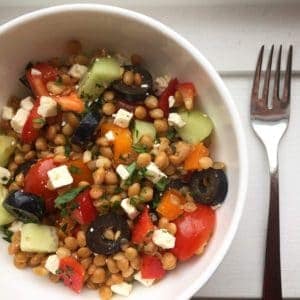
DYK: Pulses are members of the legume family and composed of dry peas, lentils, beans and chickpeas.
Why Pulses?
- Pulses are loaded with fibre (~ 8 grams per half cup).
- They are high in protein (~ 9 grams of protein per half cup).
- Rich in nutrients like iron, potassium, magnesium, zinc and B vitamins like folate that support heart health, bones, energy and brain functioning
- Helps in lowering cholesterol, blood pressure, prevention and management of diabetes.
- Pulses have one of the lowest carbon footprints of any food product.
- One of the most cost-effective protein sources. Lentils cost $0.10 per serving compared to upwards of $1.49 per serving for beef, pork or chicken.
- The newest 2015-2020 Dietary Guidelines for Americans suggests replacing some meat and poultry with pulses.
One of my favourite ways to enjoy chickpeas is to simply roast them in the oven! Here is my favourite Crunchy Rosemary Roasted Chickpeas. I use canola oil because it’s high in monounsaturated (plant-based) fats which have been shown to reduce blood cholesterol. When roasting, choose an oil with a high smoke point. At this temperature the oil starts to burn and smoke, which can destroy the nutrients in oil.
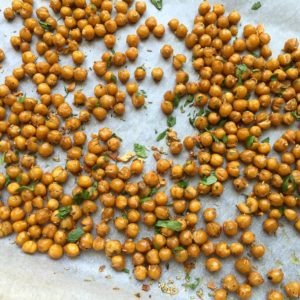
Roasted Chickpeas are great for a New Year’s snack (click here to learn how to snack like a dietitian) or eaten as part of a meal for boosting fibre and protein. They’re also versatile. Click here for my Spicy Roasted Chickpeas. Use an oil with a neutral flavour so the herbs or spices can absorbs the various flavours. Even simple salt and cracked pepper works!
Tip: When roasting, choose an oil with a high smoke point to protect the nutrients in oil.
Tips to Get Started:
- Stock your pantry with pulses like: chickpeas, black beans, lentils, Romano beans, edamame.
- Add pulses to: soups, sauces, casseroles, salads, whole grain or pasta dishes, falafel patties, baking options etc.
- Try adding lentils to ground beef (like in Bolognese sauce, stuffed peppers, chili) to increase the fibre and extend the portion prepared.
- Have canola oil as pantry staple; it’s Canadian-grown and very affordable. Perfect for roasting.
- Snack on lupini beans.
- Baked beans make a simple meal providing fibre and protein along with magnesium, potassium and iron. Add side of veggies and you have quick, easy and inexpensive meal.
- Could try a memory jog like Meatless Mondays to remind you to have your weekly intake of pulses.
- Stay recipe inspired. I love Pulse.org!
3. Have Omega-3 Fish Twice a Week.
Habit: Enjoy omega-3-rich fish twice a week.
Plus: Explore variety in the types of fish consumed and cooking methods.
Habit Forming: Availability of fish (canned/frozen/fresh). Try having “Fish Friday”, “Happy Hump Day Salmon” as memory jog.
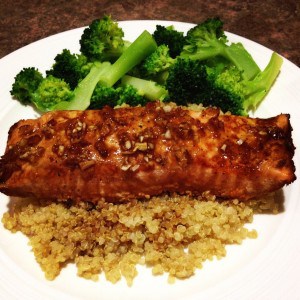
What are Omega-3 Fats?
Omega-3 is known as an ‘essential fatty acid’ since our bodies need to consume them in our diet (or supplements) in order to reap the health benefits.
There are three types of omega-3 fatty acids: EPA, DHA and ALA. Research shows greater health benefits associated with the DHA and EPA found in fatty fish opposed to the ALA.
- DHA (docosahexaenoic acid) – Found in fatty fish (i.e., salmon, anchovies, herring, mackerel, sardines, Arctic Char, trout) and algae
- EPA (eicosapentaenoic acid) – Found in fatty fish (i.e., salmon, anchovies, herring, mackerel, sardines, Arctic Char, trout) and algae
- ALA (Alpha-linolenic acid) – Found in plants (i.e., flaxseed, canola oil, chia seeds, hemp seeds, soybeans, walnuts)
Wondering the difference between #wild vs. #farmed #salmon? Find out here!
Health Benefits of Omega-3:
- Lowers risk of Heart Disease (which is the #1 cause of death for Canadians).
- Lowers triglycerides (fats in your blood) and blood pressure.
- Helps with brain, nerve and eye development for infants and pregnant mothers.
- May improve mild-to-moderate depression.
- Linked to improving rheumatoid arthritis.
- Can help reduce inflammation and could be linked with brain and cognitive health (dementia, Alzheimer’s disease).
- May play role in cancer prevention.
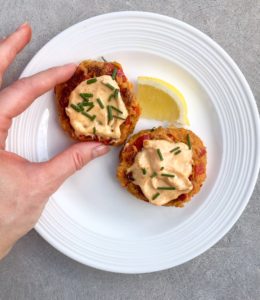
Omega-3 Recommendations:
To follow a healthy diet aim for at least 2 servings of fish per week. This provides approximately 200-500 mg of EPA and DHA per day or 1400-3500 mg per week.
Click here to see the amounts of EPA and DHA in different foods.
Omega-3 Recipe Inspiration:
One of my favourite ways to enjoy salmon for omega 3’s is to bake in the oven or sear in a frying pan for a quicker alternative! Here is my 5-Ingredient Dijon Garlic Salmon.

Tips to Get Started:
- Stock your kitchen with your favourite omega-3 rich fish (canned, frozen).
- Use canned salmon to make “salmon salad” filling to add in wraps, sandwiches or on crackers for a meal. Here’s my Salmon Fresh rolls.
- Add anchovies or sardines into tomato sauce or pizza topping.
- Bake salmon with veggies, potatoes or chickpeas.
- Pan-fry fish for a 10-minute protein source to add to your meal.
- Add canned salmon to cold pasta salad or quiche for protein and omega-boost.
- Grill fish on BBQ.
- Add omega-3 rich fish to Clam Chowder soup.
- Enjoy sushi with omega-3 rich fish. Spicy salmon rolls!
- Steam mussels.
Uncertain about mercury and fish? Click here to find out more!
Do I need an Omega-3 Supplement?
If you are not a fish fan or you are a vegetarian or vegan, you may benefit from a supplement with EPA and DHA. Check with your dietitian if you are curious on the type and amount you should be supplementing. There are high-quality vegan sources but amounts will vary depending on the brand and source.
Bottom Line:
Let’s stop the hurried mayhem in 2019. Think about carving out time for ourselves and our health by taking time to eat a high-fibre breakfast, enjoying pulses once a week and omega-3 rich fish at least twice a week. These habits can help to improve your health in the New Year. Most of all, enjoy your new habits as part of a lifestyle that you can really get excited about!

Now’s your turn! Do you make New Year’s Resolutions? What are you wanting to implement for a healthier 2019?


